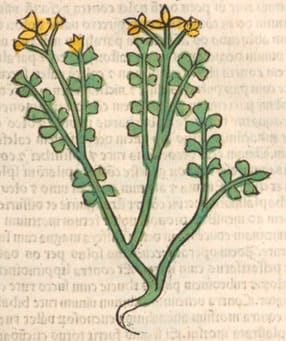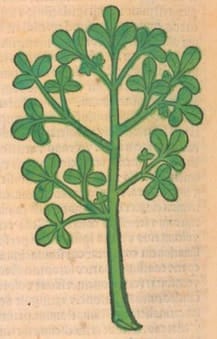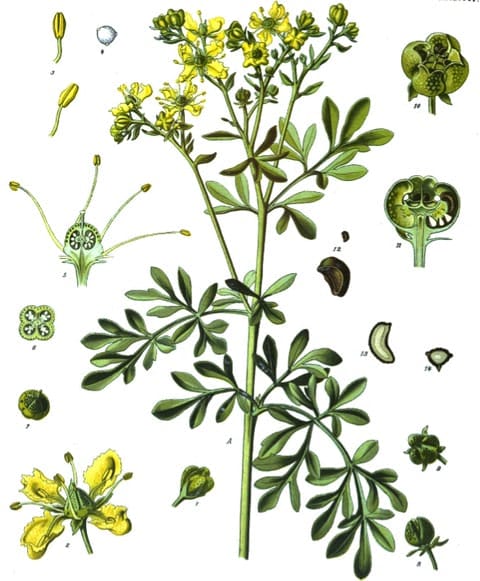Ruta, Rue‘Herb of Grace’Sudab (Unani) Sitav (Ayurveda) |

|
 Herbarius latinus, Petri, 1485
Herbarius latinus, Petri, 1485 |
 Ortus Sanitatis, Meydenbach, 1491
Ortus Sanitatis, Meydenbach, 1491 |
 Kohler’s Medizinal Pflanzen, 1887
Kohler’s Medizinal Pflanzen, 1887Botanical name:
Ruta graveolens
Parts used:
Herb; Seed
Temperature & Taste:
Warm, dry. Pungent, Bitter
“Hot and Dry in the Second degree”. (Avicenna)
Considered Cold in TCM, although it is rarely used.
Classifications:
2C INCIDERS. 2D ATTENUATERS OF CONGEALED BLOOD. 2I. ANTISPASMODIC. 2K. RESOLVENT. 2M. DRAWING. 2Z. CICATRIZING
3C. ALEXIPHARMIC. 3G. EMMENAGOGUE
4h. NEPHRITIC. 4i. UTERINE. 4k. ARTHRITIC
Uses:
1. Moves the Blood, Regulates Menstruation:
-promotes menstruation when delayed, suppressed or painful
-painful, irregular Menstruation; dark or clotted menstrual blood
-female obstructions from cold or shock.
-promotes Labor, expel a Dead Child and Afterbirth.
2. Move the Blood, clears Stasis, Eases Pain:
-bruising, stagnant or congealed blood and for all Trauma with swelling and pain.
-can be used for Tumors, including Fibroids and Cysts of the Uterus
-a special function on the Cartilage, Ligaments and Tendons; used for Sprains, Tendonitis, bone or joint pain
3. Clears Wind-Damp, Promotes Urine:
-promotes Urine in Edema or urinary obstruction
-the Oil anointed over the bladder region can promote urine
-Arthritis, Sciatica, Gout and Rheumatism (decocted in Wine)
4. Calms the Liver, Stops Wind:
–Galen noted that Rue ‘extinguishes Wind’.
-Hypertension, Tension Headaches, Palpitations with Anxiety, Hysteria, Vertigo, Dizziness
-childhood Convulsions and Epilepsy. Has been used for Infantile Convulsions in modern TCM.
-degenerative conditions including Multiple Sclerosis, and for Bell’s Palsy.
5. Clears Wind, Resists Poison:
-‘The seed taken in wine, is an antidote against all dangerous medicines or Deadly poisons’. (Culpeper)
-‘If a man be anointed with the juice of Rue, the poison of Wolf’s Bane, Mushrooms, or Toadstools, the bitings of Serpents, stingings of Scorpions, Spiders, Bees, Hornets and Wasps will not hurt him’. (Gerard)
-‘It roots out the venom of the Plague and other Poisonous and Malignant diseases, and preserves from the same’.
-Rabies
-In modern TCM, it is regarded as Cold, and is used for Wind-Heat types of Fever and Virus, as well as the Bites of Snakes, Scorpions and Centipedes. (The seeds and leaf were used for this function, the seed being preferred)
-“Counters all Poisons” (Avicenna)
6. Clears Phlegm, Resolves Swellings:
–Galen noted Rue to ‘digest all thick viscous fluids’.
-‘he hath virtue of Purging, Dissolving, and Consuming’ (A Boke of the Properties of Herbs called an Herball, 1560)
-various swellings including Scrofula, Ganglions and other phlegm-type swollen glands and Tumors. (internally and externally)
-“It dissolves Scrofula in Throat and Armpit”. (Avicenna)
7. Clears Phlegm, Stops Cough:
-cough with thick white or clear phlegm; used for chest congestion, Bronchitis, and Asthma. (West, Ayurveda)
8. Benefits the Eyesight:
-traditionally said to ‘quicken the Sight’ (Gerard); used to benefit Eyesight since Pliny.
-burning, inflamed or aching eyeballs, as well as Headaches related to Eye strain.
-weak infusion of the leaves gives much benefit when used as an eyewash.
9. Used for Melancholy:
-gently clears Melancholy Humor
-long used for Mental Illness and Insanity;
-used in enema, it quickly eliminates Black Bile (Unani)
-‘A person who is Melancholic will be better when he eats Rue after a meal’ (Hildegard).
10. Warms and Strengthens the Kidneys:
–Strangury, Edema
-Fear; promotes Bravery (Arab physicians)
-Traditionally said to be Aphrodisiac.
-Hernia (School of Salerno)
-Leukorrhea
11. Kills Worms:
-used for Worms for which it was often boiled in Milk; some preferred the seed for this purpose.
–Dioscorides recommended boiling in Olive oil and drinking for Worms
12. Externally:
-juice or Oil is applied to Warts and other skin growths.
-ointment, cataplasm or poultice formed by boiling the herb in Vinegar is applied to Rheumatism, Gout, Sciatica
-juice is also dropped into the ears for Earache.
-as a wash for sore, red eyes, and various eye diseases; 1 drop of the well diluted essential oil was previously dropped directly in the eye
-applied as a plaster with Barley for severe Eye pain (Dioscorides)
-oil or tincture is applied for Lethargy, Vertigo, Headache, Migraine
-oil was applied to spine in Fevers.
-good for Cold, Humid and Watery Tumors.
-decoction in wine is a good gargle for rotten Teeth and inflamed Gums.
-topically for Infection and Ulcers of the Skin, and for Eczema.
-with vinegar and Rose oil for itching (Unani)
-topically used for Cervical Cancer
-the fresh herb is beaten and applied to Venomous Bites and Stings
Dose:
Infusion or Brioef Decoction: 2–6 grams, up to a maximum of 9 grams being taken daily (1–2 tablespoonful per cup of boiling water)
Tincture (1:5 in 45% alcohol): 1–3, or 4 mls, 2–3 times daily;
Fluid Extract (1:1 in 45% alcohol): 5–15 drops;
Essential Oil: 1–2 drops (up to 4 or 5 drops being taken traditionally), either well diluted, or taken on sugar;
Powder: 100mg–2 grams, up to 3 grams. 100mg–1 gram promotes Menstruation. Half a teaspoonful every morning for 9 days in the treatment of Convulsions, Paralysis etc. Some said if 2 drams of powdered Rue was taken daily on an extended basis, it would achieve wondrous results;
Juice: 5mls., diluted.
Used externally in pastes, poultices, plasters, washes, enemas, douches etc.
Preparation:
1. Toasted or Stir-fried Rue
Sometimes Rue is toasted until it is yellow-brown. This lessens its pungent nature, increases its warming nature, and has the effect of restraining the Kidneys in Spermatorrhea or Premature Ejaculation. It is also milder, so is preferred for those with a delicate or weak constitution. It is also more suitable for children.
Correctives:
Aniseed (Unani)
Substitutes:
1. Oregano (Unani)
2. Peppermint (Unani)
Main Combinations:
Calamus & Rue
Gynecology & Menstruation
1. Obstructions of the Uterus, Menstrual pain and cramping and to promote Birth, Rue with Rosemary, Savin, Lavender, Marjoram, Pennyroyal, Motherwort, Cyperus rotundus, Lovage root, Orange peel, Aniseed, Cinnamon (as in Uterine Elixir)
2. Promote Menstruation:
i. Rue and Pennyroyal decocted in Wine
ii. Rue with Yarrow, Camomile, Orange peel, Fennel seed (as in Uterine Powder)
iii. Rue with Camomile, Balm, Rosemary (Kroeber)
iv. and Chlorosis, Rue with Thyme, Centaury, Maidenhair, Oregano
v. Rue, Sage, Motherwort, Pennyroyal
vi. Rue with Black Cohosh
3. Suppressed or Obstructed Menstruation:
i. Rue, Pennyroyal, Southernwood, Mugwort
ii. Rue with Cinnamon, Myrrh, Savin, Celery seed, Asarum, Rhubarb, Saffron, Madder, Wormwood, Pennyroyal (as in Tincture for Suppressed Menstruation)
4. Pre-Menstrual Syndrome (PMS):
i. Rue with Sage
ii. Rue, Angnus Castus, Pennyroyal
iii. Rue, Balm, St. John’s wort
5. Leukorrhea, Rue with Agnus Castus, Fennel, Cinnamon (as in Powder for Leukorrhea)
6. Infertility from Damp-Phlegm obstruction, Rue, Pennyroyal, Wormwood, Poke root,
7. Expel the Afterbirth or a Dead Child:
i. Triphera Magna is taken with Rue juice, (Herbarius latinus, Petri, 1485)
ii. Pessary with Rue and Myrrh
7. Trichomonas vaginalis, Rue with Violet
Head and Nerves:
8. Headache, Rue with Fennel seed and Lovage (as in Potion for Headache of Galen)
9. Diseases of the Head (Epilepsy, Vertigo, Dizziness etc):
i. Rue with Oregano, Balm, Marjoram, Rosemary, Betony, Sage, Clove, Nutmeg, Aniseed, Siler, Pyrethrum (as in Powder for Epilepsy of Philon)
ii. Rue with Peony, Calamus, Mistletoe, Betony, Sage, Marjoram, Calamint, Rue, Peony, Juniper, Rosemary (as in Cephalic Decoction)
iii. Rue with Amber, Savin, Frankincense, Cannabis seed, Stoechas (as in Cephalic Powder)
10. Epilepsy, Convulsions:
i. Rue, Peony, Mistletoe
ii. from Wind-Phlegm, Rue, Pyrethrum
iii. Rue, Peony, Rosemary (Herbarius latinus, Petri, 1485)
iv. Rue, Mistletoe, Motherwort, Pellitory of the Wall, Tansy (as a decoction) (Valuable Herbal Prescriptions, late ‘s)
11. Vertigo, Rue, Horehound, Pennyroyal; decoct until one-third has wasted. Strain, add Honey, and boil until thick. Take 1–2 spoonfuls each morning for 7 mornings.
12. Insomnia:
i. Rue with Camomile
ii. Rue with Lavender
13. Nightmares:
i. Rue with Balm
ii. Rue with Schisandra
Eyes and Eyesight
14. Poor or failing Eyesight:
i. “It strengthens the Eye-sight specially when its extract is taken orally or used as a kohl [collyrium] alongwith the extract of Fennel and Honey”. (Avicenna)
ii. Rue decocted in wine and given (Herbarius latinus, Petri, 1485)
iii. Rue is often combined with Fennel seed
iv. Rue Water, Eyebright Water (Herbarium Horstianum, 1630)
v. Rue, Eyebright, Betony
vi. Rue, Eyebright, Betony, Rosemary, Elecampane, Fennel root, Chebulic Myrobalan, Rue seed, Lovage seed
Heart & Blood
15. Heart pain and Angina, Rue with Balm and Mother of Thyme (Schönmehl)
16. Hypertension:
i. Rue and Kelp
ii. Rue and Rosemary
17. Anemia, Rue with Calamus, Sarsaparilla, Elecampane, (Bischoff)
Infection / Poison:
18. Preservative against infection:
i. Rue with Walnut, Figs
ii. Rue with Walnut, Figs, Juniper berry
iii. Walnut, Fig, Rue, Salt, Honey Electuary of Nuts (Mithridate)
iv. Rue with Balm, Calendula, Angelica, Zedoary, unripe Walnuts, Citrons (as in Preservative Water)
19. To prevent Rabies once bitten, Rue with Vervain, Sage, Plantain, Wormwood, Mint, Balm, Betony, St. John’s wort (as in Powder Against Rabies)
20. Poison: “If consumption of Poison is suspected or there is insect bite it is advised to take 3.5 gm of its seeds and leaves together with wine. In such cases it is, specially, taken orally with powdered Fig and Walnut”. (Avicenna)
21. Gonorrhea: Lettuce seed, Cannabis seed, Rue seed (as in Powder for Gonorrhea from Heat)
Lungs
22. Cough:
i. Rue with Hyssop and Fig (Dioscorides)
ii. Rue with Horehound, Hyssop, Thyme, Pennyroyal, Aniseed (as in Decoction for Cold Coughs of Nicolas Myrepsus)
iii. ‘dangerous cough’, Rue with Sage and Cumin (The Physicians of Myddvai)
23. Cough, difficulty Breathing:
i. “decoction of fresh common Rue with dry Dill in chest pain and difficult Breathings”. (Avicenna)
ii. Rue with Dill, Fennel seed
Gastrointestinal
24. Loss of appetite, Rue with Sage and Wormwood
25. Indigestion, Stomach Pain, Abdominal fullness, Food Stagnation, Rue, Cumin, Long Pepper (as in Lesser Cumin Composition of Galen)
26. Stomach pain:
i. Rue with Camomile, Marjoram, Pennyroyal, Rosemary, Cumin, Aniseed, Fennel seed, Dill seed (as in Decoction for Stomach Pain)
ii. Rue with Cumin, Nigella, Caraway, Bitter Almond, Long Pepper, Marjoram, Wild Mint, Calamus, Bay berry (as in Electuary of Bayberries)
27. Hernia, Rue with Elecampane (School of Salerno)
28. Liver and Spleen obstruction, decoction Rue with Fennel root
Urinary
29. Edema, Rue Water with Syrup of Two Roots (Herbarium Horstianum, 1630)
30. Incontinence:
i. Rue with Acorn, Frankincense, Myrrh, Calamus (as in Powder for Incontinence of Alexander Benedictus)
ii. Rue seed with Comfrey, Cyperus rotundus, Plantain, Horsetail, Agnus Castus, Frankincense (as in Wine for Incontinence)
31. Enuresis in children, Rue with St. John’s wort, Camomile
32. Dribbling Urine, Rue with Saw Palmetto
33. Strangury, Dysuria, Rue and Dill decocted in wine and oil and applied to teh pubis.
Male disorders
34. Premature Ejaculation, use Unripe Rue, Toasted Rue, Poppy seed, Sesame seed (as in Pills of Hindi Mumsik of Unani)
35. Spermatorrhea, Premature Ejaculation:
i. Rue with Angus Castus, Rose, Pomegranate, Lettuce, Licorice (as in Powder of Licorice of Unani)
ii. Rue seed, Mint, Agnus Castus, Orris, Lettuce seed (as in Powder for Gonorrhea)
36. To quench Lust, Rue with Sage and Rose (School of Salerno)
37. Swollen and inflamed Testicles:
i. from abstinence, Rue with Wormwood (Hildegard)
ii. Rue with Bay leaves (Dioscorides)
Other
38. Joint pain:
i. beat Raisin pulp with fresh Rue leaves and apply (The Secrets of Alexis, 1615)
ii. Rue with Ground Pine, Germander, Gentian (as in Powder Against Joint Pain)
39. Obstruction of the Liver and Spleen, Rue, Worwood, Tamarisk bark, Broom flower (Herbarius latinus, Petri, 1485)
Externally
40. Lameness, bathe in a decoction of Rue and Rosemary, or prepare an Oil for external use
41. Fistula in the corner of the Eye, decoct Rue, Agrimony and Celandine in Brandy; apply 3 times daily (Wirtzung)
42. Tinnitus, Rue with Marjoram, Stoechas, Wild Mint, Camomile as a tincture topically
43. Erysipelas, Shingles, Rue with Vinegar, White Lead and Ointment of Rose (Dioscorides)
44. Toothache, Rue and Pyrethrum decocted in wine as a mouthwash. (Herbarius latinus, Petri, 1485)
45. Testicular Inflammation, Rue with Bay leaf topically. (Avicenna)
Major Formula:
Decoction of Hyssop and Rue
Cephalic Decoction (Charras)
Decoction for Cold Coughs (Nicolas Myrepsus)
Decoction of Elecampane and Rue
Decoction for Chlorosis
Syrup of Betony (Bononiense)
Syrup of Mugwort (Augustana)
Tincture Against Schirrus of the Spleen
Electuary of Nuts (Mithridate)
Electuary of Dates (Diaphoenicum) (Mesue)
Electuary of Hyssop (Diahyssopus) (Nicholas)
Electuary of Bayberries (Electuarium de Baccis Lauri)
Electuary of Bayberries (Zacharia)
Electuary of Sulphur (Unani)
Lesser Cumin Composition of Galen
Confection of Eyebright (Confectio Humain) (Mesue)
Powder of Licorice (Unani)
Powder Against Rabies
Powder for Spermatorrhea
Uterine Powder (Species Hysterica)
Foetid Pills Minor of Galen
Foetid Pills Major of Galen
Foetid Pills (Mesue)
Pills for Premature Ejaculation (Unani)
Pills for Premature Ejaculation (Habb Hindi Mumsik)
Pills to Aggregate Greater (Mesue)
Oil for Lameness
Cautions:
1. Not used during Pregnancy or when Breastfeeding (it can dry up milk)
2. Not used in Uterine Bleeding
3. Not used in Yin deficiency (very drying)
4. Harmful to the Bladder and abdominal viscera. (Mahadevadeva, Unani)
5. Some people may experience Melancholy or sleep disorders with use of Rue.
6. “Common rue makes the Semen dry (viscid and retentive) and reduces the Sexual Desire”. (Avicenna)
7. Phototoxicity can occur with usage of Rue.
Main Preparations used:
Conserve, Extract, Distilled Water, Vinegar, Distilled Water, Infused Oil, Tincture of Rue
1. Conserve of Rue:
i. fresh leaves of Rue, White Sugar (equal parts). Beat. (Pharmacopoeia Sardoa, 1773)
2. Extract of Rue:
i. fresh Rue (1 lb.), Water (8 lbs.). Boil to half, express, strain. Evaporate slowly to the thickness of a pill-mass. .
3. Vinegar of Rue:
i. fresh leaves of Rue (1 part), Vinegar (10 parts). Macerate without heat for several days, express, filter. (Pharmacopee Usuelle, Louvain, 1821)
4. Distilled Water of Rue:
i. Rue, bruised (1 part), Water (4 parts). Distil two parts. (Dispensatorium medico pharmaceuticum Palatinatus, 1764)
5. Infused Oil of Rue:
i. Fresh Rue, Olive oil (equal parts). Digest 3 days, express (Dispensatorium Pharmaceuticum, 1777)
-
More Info
-
History
- Research
|
‘The leaves dried and burnt are used by the Hindus for the purpose of fumigating young children suffering from catarrh; they are also used fresh, bruised and mixed with arrack as an external remedy in the first stages of paralytic affections; dried and powdered they are prescribed in conjunction with aromatics in cases of dyspepsia; they are considered to be injurious to pregnant women; an opinion also entertained by Dioscorides. Rue was held in high estimation by the Greeks and Romans, and was a principal ingredient in the celebrated antidote of Mithridates. Pliny notices it in several parts of his Natural History, and calls it one of the best medicinal herbs. Celsus says of Rue, ” Urinam movet, sensus excitat, purgat, mollit.” Hippocrates considered it to be resolvent and diuretic, and notices it in his chapter on female diseases. The Arabians class Rue among their attenuentia, vesicatoria and stimulantia. The author of the Makhzan-el-Adwiya describes three kinds—garden, wild, and mountain Rue, He considers it to be hot and dry in the third degree, to increase the mental powers, to act as a tonic and digestive, and to increase the urinary and menstrual excretions. He also states that it acts as an antaphrodisiac and causes abortion when given to pregnant women. The diseases in which it is recommended are so numerous that I must refer the reader to his article “Sudab.” Early European practitioners considered Rue to be antispasmodic, stimulant and emmenagogue, and prescribed it in hysteria and flatulent colic. Boerhaave extols its virtues in promoting perspiration. |
In the Schola Salerni, the following lines occur :— “Ruta facit castuni ; dat lumen, et inherit astum. Cocta facit ruta, de pulicibus locatuta.” Rue is the Herb Grace of old English writers, and is still much used as a domestic remedy. Alibert says of it, “Cetto plante a un grande action sur le systeme nervenx, et particulierement sur le systeme uterin. Beaucoup de femmes en prennent dans les menstrues laborieuses.” The dose of the powdered leaves is from ten grains to a scruple or more, twice or thrice daily. Rue occupies a corner in most Bombay gardens; it grows freely, but does not generally flower. Rue is an active irritant, whether applied externally or taken internally. It has been frequently used with success to procure abortion; sometimes it produces painful vomiting, always great prostration, confusion of mind, cloudy vision, feebleness and slowness of pulse, coldness of the extremities, and twitching of the limbs; in pregnant women the drug produces pain in the back, bearing down, and frequent micturition, followed by pains and abortion about ten days after the commencement of its administration. Oil of Rue has been observed to produce similar symptoms with increased frequency and diminished tension of the pulse; on the other hand, when an infusion of the dry leaves was used, the pulse fell from 80 to 69 in three hours.— (Van de Warker, Criminal Abortion, 1872.) (Vegetable Materia Medica of Western India, Dymock, 1885 |
